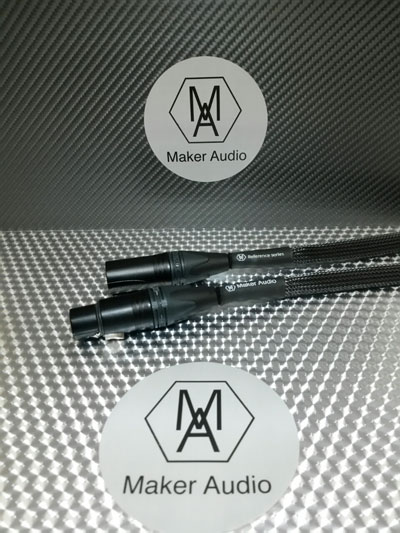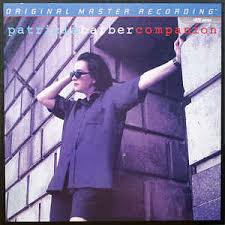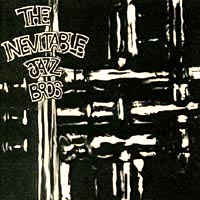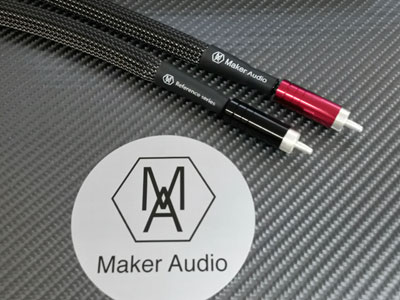Maker Audio Reference Cables
 Tom Maker has been a leading audio designer for quite some time. He started Edge Electronics in 1988 and received many awards for his insightful Edge amplifiers, preamplifiers, and CD Players. He sold Edge in 2008 to RB MFG in Chicago, and then set about to found his own company, Maker Audio.
Tom Maker has been a leading audio designer for quite some time. He started Edge Electronics in 1988 and received many awards for his insightful Edge amplifiers, preamplifiers, and CD Players. He sold Edge in 2008 to RB MFG in Chicago, and then set about to found his own company, Maker Audio.
Before building amplifiers Tom produced some 20 different home loudspeaker models and in 2006 he returned to speaker design, which he is now continuing to refine and produce at Maker Audio.
 From what I’ve read in the consumer audio publications, Edge has a reputation for offering cutting edge products that endeavor to redesign the state-of-the-art. And now it appears that Tom Maker is applying his virtuosity to in the arcane world of cable design.Maker has also designed and manufactured cables for other audio companies as well as companies involved in satellite communications. This is a review of Maker’s Reference Interconnect cables with comments on his Reference power cord as well.
From what I’ve read in the consumer audio publications, Edge has a reputation for offering cutting edge products that endeavor to redesign the state-of-the-art. And now it appears that Tom Maker is applying his virtuosity to in the arcane world of cable design.Maker has also designed and manufactured cables for other audio companies as well as companies involved in satellite communications. This is a review of Maker’s Reference Interconnect cables with comments on his Reference power cord as well.
Features
Tom Maker was good enough to send me this overview of his cable manufacturing process—some of which is proprietary to Maker Audio:

Our cables start life as 99.9% pure copper (Reference series) and silver (Master Reference) and they are cryogenically processed, but not in spooled form. They are done as straight lengths and then run though a special annealing process that is proprietary to us.
Cable batches are then induction heated to improve break in times. Cables are manufactured in matched pairs, so to minimize differences between the cables.
Cables also have shielding as well as RF carbon foam shielding to dissipate high frequencies traveling along the cable so they are not passed on to other components. Additionally, the cables incorporate RF nulling blocks along their length to remove lower frequencies running on the outside of the cable. These RF null blocks use a proprietary magnetic material, so as to cover a wide range of frequencies.
Cable ends use silver solder and either gold or silver contacts and housings with Teflon insulators. Contacts are also treated with an anti oxidation coating to facilitate better connections.
Exterior braiding is also electrically conductive at high frequencies to minimize RF propagation.
Perhaps the best news is their “affordability”, ($655/1-meter RCA or $725 for Balanced XLR) and the price per additional meter is only $50-RCA and $75-XLR. Both the RCA and XLR cables come with silver-plated Teflon insulators.
For my listening tests I mainly used a pair of 2-meter XLR cables or a 2-meter pair of the Maker Reference RCA cables between my Lyngdorf DPA-1 preamplifier and my Rogue Audio ST-100 stereo power amplifier to drive my Legacy Audio Focus SE speakers.
Listening: I’m a Believer!
My initial view of the Maker Reference cables (MRC) is that they are very fast, nuanced, well focused, and extremely low in noise though a bit thin in the lower midrange. But my opinion after more break-in time is that the lower midrange filled out and everything I initially liked a out the Maker cables only got better. My impressions below were written with 50 or 60 hours of additional break in.
 I recall putting on Shaggy’s Hot Shot CD (MCA 088 112-096-2) and the opening bass beats almost knocked me off the sofa. And the thing I observed about the Maker Reference bass performance was that it was not only deep and articulate, but was also very powerful. But the intro of “Hot Shot” had powerful drums on the left channel and a kind of interesting bass echo on the right channel. Anyway, it is a neat effect and was perfectly reproduced by the MRC. Shaggy’s “Dance and Shout” also had some attention-grabbing stereo drum effects that proceeded to blow my mind.
I recall putting on Shaggy’s Hot Shot CD (MCA 088 112-096-2) and the opening bass beats almost knocked me off the sofa. And the thing I observed about the Maker Reference bass performance was that it was not only deep and articulate, but was also very powerful. But the intro of “Hot Shot” had powerful drums on the left channel and a kind of interesting bass echo on the right channel. Anyway, it is a neat effect and was perfectly reproduced by the MRC. Shaggy’s “Dance and Shout” also had some attention-grabbing stereo drum effects that proceeded to blow my mind.
I will admit that I had played this Shaggy CD a bunch of times but had never experienced its captivating effects to this degree.
 Switching to Patricia Barber’s live Companion CD (Blue Note/Premonition 7243 5 22963 2 3), playing her cover of “Use Me,” a pitch-perfect stand-up bass punctuated her words and provided meter to her sexy performance. Track 5, “Touch of Trash” showcased Patricia’s emotive vocal against the backdrop of the full drum kit and a provocative array of high-frequency percussive sounds—and it all sounded as if it were happening right in my room in front of me. The instrumental image focus and image density/palpability is outstanding! It was another sexy (kind of erotic, really) song performed as only Ms. Barber could deliver it. Great lyrics too!! (Don’t tell Patricia, but I actually had the impression, from her soulful vocals, that she is a black woman—then I saw a video recording of her performing at the Newport Jazz Festival and wha-da-ya-know, she be a Caucasian!!)
Switching to Patricia Barber’s live Companion CD (Blue Note/Premonition 7243 5 22963 2 3), playing her cover of “Use Me,” a pitch-perfect stand-up bass punctuated her words and provided meter to her sexy performance. Track 5, “Touch of Trash” showcased Patricia’s emotive vocal against the backdrop of the full drum kit and a provocative array of high-frequency percussive sounds—and it all sounded as if it were happening right in my room in front of me. The instrumental image focus and image density/palpability is outstanding! It was another sexy (kind of erotic, really) song performed as only Ms. Barber could deliver it. Great lyrics too!! (Don’t tell Patricia, but I actually had the impression, from her soulful vocals, that she is a black woman—then I saw a video recording of her performing at the Newport Jazz Festival and wha-da-ya-know, she be a Caucasian!!)
 I have another great jazz CD that I use for reference from a small band from Tucson AZ. The Inevitable Jazz Bros CD (Recorded, mixed, and mastered by Brian Davies at Sandtrap Studios) features a great small group of jazzmen, that play classic tunes using the trumpet, baritone sax, banjo and high-hat, and even a kazoo. Really, it’s just too much fun!
I have another great jazz CD that I use for reference from a small band from Tucson AZ. The Inevitable Jazz Bros CD (Recorded, mixed, and mastered by Brian Davies at Sandtrap Studios) features a great small group of jazzmen, that play classic tunes using the trumpet, baritone sax, banjo and high-hat, and even a kazoo. Really, it’s just too much fun!
I will say that when listening to songs like “Honey Pie” and “Major Wagner,” I never heard these instruments sound so real except when I had the opportunity to hear the Jazz Bros themselves playing their songs 12 feet in front of me at our local park on one fortuitous Tucson day.
The brass compliment smacked of reality and fine nuance, while the banjo, which is particularly difficult for an audio system to get right, showed its snap, speed and musically engaging sound (I love the banjo!). Heck, even the kazoo was righteous and tastefully implemented. J
Moving to my Michell TecnoDec turntable, I first played Johnny Cash’s first album from American Recordings (American 9 45529-1). Beginning with “Bird on a Wire,” the beautiful sound and cavity resonance of Johnny’s acoustic guitar was captured perfectly—surpassing my previous reality of this excellent recording. This not to mention that Johnny’s husky tenor vocal could fool a lot of people into thinking he was in the room performing live. The overall sound was very rich and involving indeed.
Another of my favorite Cash songs, “Down There By the Train,” was quite lifelike, rich, and dynamic. The way Johnny belts it out and hammers his guitar, well, that tune always gets me and the Maker cables let it fly (gave it wings, like Red Bull).
Moving on to one of my favorites, Igor Stravinsky Conducts 1961, (Columbia Masterworks MS 6272), from L’ Histoire du Soldat: Three Dances: Tango, Waltz, Ragtime, the strings, brasses, and woodwinds all spoke the truth in a more honest way than I am used to hearing. Both the high frequency percussion and the tympani shined of authenticity. The cymbals shimmered with air and dynamic contrasts and I was able to hear more of the character of the decay of the tympani drums than I can ever remember hearing in the past.
I should also note that with the Maker cables the soundstage seemed to deepen and allow me to hear low-level details at the rear of the soundstage that were not audible with other cables in my experience. Not only that, but the MRC’s had the quietest background of any cables I have used to date. Well done, Tom Maker!!
In addition, Tom Maker sent me an early version of his new blue-jacketed “Master Reference” interconnects to try, which use silver conductors. My feeling is that the Master Reference was just a touch bright sounding on my Legacy Focus SE speakers and that on balance, the less expensive Reference series cables are a better match in my particular system.
Caveats
Hmmm—no real caveats to report other than the Maker Reference cables require a little bit of break-in to sound their very best. At first blush, the Maker Reference sounded quite good and had no discernible deficiencies other than the lower midrange seemed just a touch thin, but with just 10 or 20 break-in hours it appeared perfectly linear to me—so I suppose that is not an actual caveat…
Conclusion
I certainly enjoyed my time listening to the Maker Audio Reference cables, and I think it’s fair to say that my system never sounded quite as good with any of my previous cable choices.
The Reference Series has many strengths including power at the frequency extremes, transient speed, ultra-low noise background and fine detailing like I’ve never heard before. At their very reasonable prices I believe they will be an excellent choice for many systems providing top-tier performance without breaking the bank.
While I don’t understand every detail that Tom told me about the cable’s design and construction I can relate to their captivating and musical performance very well. I recommend to anyone who is interested in upgrading their system cabling, they should definitely put these fine Maker Audio cables on their “must audition” list!


frank alles
Manufacturer
Maker Audio
Phone: +1 239-887-2631
Web: http://www.MakerAudio.com
E-mail: Tom@makeraudio.com
Maker Audio Reference Series Interconnects and AC Cord
Base Prices: Reference RCA interconnects, 1-meter – $655
Maker Audio Reference Balanced XLR interconnects 1-meter – $725
Maker Audio Reference AC Power Cord 1.5 meter from $625/15-amp, and $650/20-amp. Contact Maker Audio for all options before ordering.
Stereo Times Masthead
Publisher/Founder
Clement Perry
Editor
Dave Thomas
Senior Editors
Frank Alles, Mike Girardi, Russell Lichter, Terry London, Moreno Mitchell, Paul Szabady, Bill Wells, Mike Wright, and Stephen Yan,
Current Contributors
David Abramson, Tim Barrall, Dave Allison, Ron Cook, Lewis Dardick, John Hoffman, Dan Secula, Don Shaulis, Greg Simmons, Eric Teh, Greg Voth, Richard Willie, Ed Van Winkle, Rob Dockery, Richard Doran, and Daveed Turek
Site Management Clement Perry
Ad Designer: Martin Perry








Be the first to comment on: Maker Audio Reference Cables